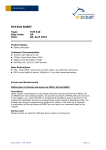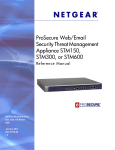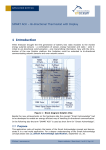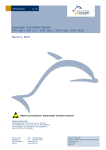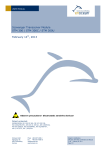Download Headline: Formatvorlage „eo_pm_head“
Transcript
STATUS SHEET STATUS SHEET Type: Step Code: Date: STM 300C DA 06. July 2011 Product Status Series production Customer Documentation STM300 User Manual V1.30 STM300 Data Sheet March 2010 Dolphin Core Description V0.96 Spec Restrictions DAC: small offset, inaccuracy at small values, not uniformly continuous VDD current peak of several 100mA for 2-4 µs after powerup/wakeup Errata and Workarounds Data telegram is not sent when the manufacturer ID is not stored Description: When DI_3 is connected to ground the module does not transmit a telegram if no manufacturer ID is stored in the configuration area. Workaround: a) Store manufacturer ID in configuration area b) Upgrade firmware. A hotfix is available from EnOcean on request. Configuration of SCO pin polarity not working Description: STM300 allows configuration of the polarity of the SCO pin via the configuration area. This configuration does not work because the firmware overwrites this information. Workaround: a) Design external electronics to work with the predefined SCO configuration b) Upgrade firmware. A hotfix is available from EnOcean on request. Status Sheet –STM 300C DA Page 1/3 STATUS SHEET Malfunction of internal pull-downs at PROG_EN and RESET Description: Under certain circumstances it can happen that the internal pull-downs at PROG_EN and RESET are not working properly. In case the pull-down at PROG_EN does not work it can happen, e.g. under bad EMI or temperature conditions, that at start-up of the module the bootloader jumps into programming mode instead of operating mode. The module then hangs in programming mode and a reset or new start-up is required. A malfunction of the pull-down at RESET pin can lead to an unwanted reset of the module. Workaround: Please connect an external 10kΩ pull-down resistor to these pins! UART hangs up (transmitting) or looses bytes (receiving) during full duplex operation Description Under certain circumstances it is possible that an UART transmit or receive interrupt is lost. This only happens during full duplex (simultaneous transmitting and receiving) serial operation. The transmit and receive interrupt flags are bit-addressable in the 8051 SFR (special function register) space and are located in the same 8 bit register. From software perspective clearing of an interrupt flag is an atomic operation, but on the hardware side, a read-modify-write occurs (since the register is a single 8-bit unit). The problem now occurs when a new transmit/receive interrupt occurs (respective interrupt flag is set) between the read and write cycles. There are two possible scenarios resulting in two different effects: 1. During clearing of a receive interrupt flag the transmit interrupt flag is set (TI occurs within 2 clock cycles after an RI=0 instruction). Then the transmit interrupt flag is accidental cleared and transmitting of further bytes will hangs up. 2. During clearing of a transmit interrupt flag the receive interrupt flag is set (RI occurs within 2 clock cycles after an TI=0 instruction). Then the receive interrupt flag is accidental cleared and the received byte will be lost. Workaround 1. Use half duplex communication If possible use half duplex communication. This will completely avoid the behaviour described above. 2. Avoid hanging up of transmitting bytes by adding a timeout mechanism The Dolphin API (>= V1.4.0.0) has implemented a timeout mechanism using the system scheduler (timer interrupt). With every 1 ms tick the scheduler proves if UART transmission is ongoing and whether the communication was locked or not. If it was locked the scheduler unlocks this manually and the error log counter ERR_UART_TX_INT_LOST is incremented. This will result in an inter-byte delay between 1 ms (best case) and 4 ms (worst case) of the transmitted bytes. If the Application is using the API System log feature, it is possible to detect this unlock events (for more info read EO3000I_API.chm->Error Diagnostic->System Log). Note: This API workaround does not apply to ultra low power applications where the scheduler is not running! Status Sheet –STM 300C DA Page 2/3 STATUS SHEET 3. Handling of lost received bytes There is no workaround completely avoiding loosing a received byte. The Dolphin API (>= V1.4.0.0) has implemented a mechanism where a newly received byte is also detected under the error condition if the new byte has a different value than the previous one (does not work if the bytes are identical). In such case the ERR_UART_RX_INT_LOST is incremented. If the Application is using the API System log feature, it is possible to detect this rescue events (for more info read EO3000I_API.chm->Error Diagnostic->System Log). Additionally using of a protocol, e.g. ESP2 (using the Serial Telegram Checksum) or ESP3 (using the Packet CRC8), allows to detect lost bytes and to request and resend the data. Status Sheet –STM 300C DA Page 3/3



